Ethnoveterinary treatments by dromedary camel herders in the Suleiman Mountainous Region in Pakistan: an observation and questionnaire study
- PMID: 20565919
- PMCID: PMC3224957
- DOI: 10.1186/1746-4269-6-16
Ethnoveterinary treatments by dromedary camel herders in the Suleiman Mountainous Region in Pakistan: an observation and questionnaire study
Abstract
Background: The Suleiman mountainous region is an important cradle of animal domestication and the habitat of many indigenous livestock breeds. The dromedary camel is a highly appreciated and valued animal and represents an important genetic resource. Camel herders, living in remote areas, have developed their own ways to treat diseases in camels, based on a long time of experience.
Methods: Information about the diseases and the ethnoveterinary practices performed was collected from a total of 90 herders and healers by interviews and participant observations.
Results: The respondents classified the diseased in major and minor fractions. Clinical signs were given in detail. Mange followed by trypanosomosis and orf were considered the most prevalent diseases, and also caused the greatest economic losses. Orf was regarded the most complex disease. The season was considered to have great influence on the occurrence of the diseases. A variety of different treatments were described, such as medicinal plants, cauterization, odorant/fly repellents, pesticides, larvicides, cold drink, yogurt and supportive therapy (hot food, hot drink).
Conclusions: There is paramount need to document and validate the indigenous knowledge about animal agriculture in general and ethnoveterinary practices in particular. This knowledge is rapidly disappearing and represents a cultural heritage as well as a valuable resource for attaining food security and sovereignty.
Figures






Similar articles
-
Ethnoveterinary plants of Pakistan: a review.J Ethnobiol Ethnomed. 2020 May 15;16(1):25. doi: 10.1186/s13002-020-00369-1. J Ethnobiol Ethnomed. 2020. PMID: 32414421 Free PMC article. Review.
-
Ethnoveterinary of Sahrawi pastoralists of Western Sahara: camel diseases and remedies.J Ethnobiol Ethnomed. 2015 Jun 20;11:54. doi: 10.1186/s13002-015-0040-4. J Ethnobiol Ethnomed. 2015. PMID: 26087846 Free PMC article.
-
Ethnoveterinary plant remedies used by Nu people in NW Yunnan of China.J Ethnobiol Ethnomed. 2010 Aug 26;6:24. doi: 10.1186/1746-4269-6-24. J Ethnobiol Ethnomed. 2010. PMID: 20796273 Free PMC article.
-
Botanical ethnoveterinary therapies in three districts of the Lesser Himalayas of Pakistan.J Ethnobiol Ethnomed. 2013 Dec 20;9:84. doi: 10.1186/1746-4269-9-84. J Ethnobiol Ethnomed. 2013. PMID: 24359615 Free PMC article.
-
Potential of ethno-veterinary medicine in animal health care practices in the South Pacific Island countries: a review.Trop Anim Health Prod. 2020 Sep;52(5):2193-2203. doi: 10.1007/s11250-019-02192-7. Epub 2020 Jan 4. Trop Anim Health Prod. 2020. PMID: 31900732 Review.
Cited by
-
Ethnoveterinary botanical survey of medicinal plants used in Pashto, Punjabi and Saraiki communities of Southwest Pakistan.Vet Med Sci. 2021 Sep;7(5):2068-2085. doi: 10.1002/vms3.582. Epub 2021 Jul 22. Vet Med Sci. 2021. PMID: 34291882 Free PMC article.
-
Ethno-veterinary uses of Poaceae in Punjab, Pakistan.PLoS One. 2020 Nov 3;15(11):e0241705. doi: 10.1371/journal.pone.0241705. eCollection 2020. PLoS One. 2020. PMID: 33142315 Free PMC article.
-
Ethnoveterinary plants of Pakistan: a review.J Ethnobiol Ethnomed. 2020 May 15;16(1):25. doi: 10.1186/s13002-020-00369-1. J Ethnobiol Ethnomed. 2020. PMID: 32414421 Free PMC article. Review.
-
Field investigation and phylogenetic characterization of orf virus (ORFV) circulating in small ruminants and Pseudocowpoxvirus (PCPV) in dromedary camels of eastern Sudan.Heliyon. 2020 Mar 21;6(3):e03595. doi: 10.1016/j.heliyon.2020.e03595. eCollection 2020 Mar. Heliyon. 2020. PMID: 32258461 Free PMC article.
-
Ethnoveterinary health management practices using medicinal plants in South Asia - a review.Vet Res Commun. 2017 Jun;41(2):147-168. doi: 10.1007/s11259-017-9683-z. Epub 2017 Apr 12. Vet Res Commun. 2017. PMID: 28405866 Review.
References
-
- Köhler-Rollefson I, Mundy P, Mathias E. A field manual of camel diseases; Traditional and modern health care for the dromedary. ITDG Publishing, London; 2001.
-
- Steinfeld H, Gerber P, Wassenaar T, Castel V, Rosales M, de Haan C. Livestock's long shadow - Environmental issues and options. Food and Agriculture Organization of the United Nations (FAO), Rome, Italy;
-
- Geerlings E. MSc thesis. Environ Sci Wageningen University, Deventer, The Netherlands; 2001. Sheep husbandry and Ethnoveterinary knowledge of Raika sheep pastoralists in Rajasthan, India.
MeSH terms
LinkOut - more resources
Full Text Sources

